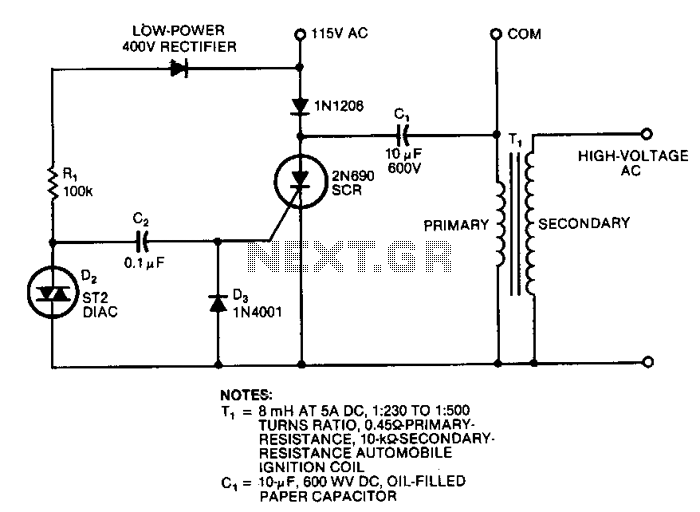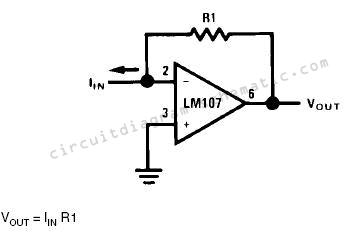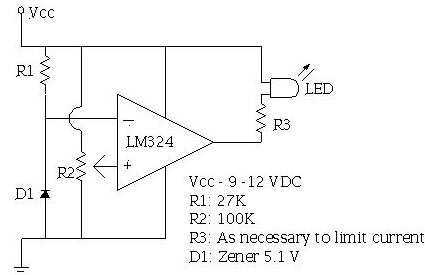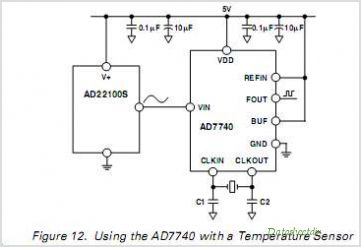
Low-Power Voltage Reference
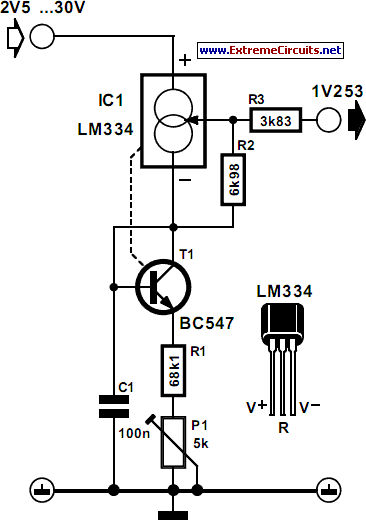
The current source IC Type LM334 is utilized in this specialized application, which features a minimal temperature coefficient and operates with a very low current draw of only 10 µA at room temperature. This current increases slightly with higher temperatures, only by a few microamperes. The circuit functions as a bandgap reference, leveraging the positive temperature coefficient of the LM334 in conjunction with the negative temperature coefficient of a transistor's base-emitter junction, ensuring effective thermal coupling. To achieve a near-zero temperature coefficient, the output voltage is precisely adjusted to 1.253 V using potentiometer P1. It is recommended to accurately measure the set value of P1 after adjustment and replace the combination of resistor R1 and P1 with a fixed resistor of the exact value, preferably a 1% metal-oxide film type from the E96 series. The current source IC1 is connected at the control input, resulting in a reference source with a negative output resistance of approximately 3.8 kΩ. Resistor R3 is used to ensure that the final output resistance is around 400 Ω. The load current is limited to a maximum of 5 µA. The reference circuit exhibits excellent performance; when the input voltage is varied from 5 V to 30 V, the output voltage changes by only 0.6 µV (from 1.2530 V to 1.2536 V). The temperature coefficient remains below 50 ppm/°C and can be further minimized to as low as 5 ppm/°C with careful adjustment. The prototype draws a current of 9.8 µA at an ambient temperature of 22 °C.
This circuit utilizes the LM334 current source IC, which is known for its low temperature coefficient and minimal current draw, making it suitable for precision applications. The design incorporates a bandgap reference technique, which leverages the characteristics of the LM334 and a transistor to maintain a stable output voltage across varying temperatures. The combination of the positive temperature coefficient of the LM334 and the negative temperature coefficient of the transistor's base-emitter junction effectively cancels out temperature-induced variations in output voltage.
The output voltage is meticulously set to 1.253 V, which is a common reference voltage for precision applications. The adjustment of potentiometer P1 allows for fine-tuning of this voltage, but it is crucial to replace the adjustable components with fixed resistors after calibration to ensure long-term stability and accuracy. The use of a 1% tolerance metal-oxide film resistor from the E96 series enhances the precision of the circuit.
The reference circuit's design includes a negative output resistance feature, achieved through the configuration of IC1, which stabilizes the output against variations in load current. Resistor R3 plays a vital role in maintaining the desired output resistance, ensuring that the circuit can supply a stable load current without significant fluctuations.
The performance metrics of this reference circuit are noteworthy, with minimal output voltage variation despite significant changes in input voltage. This characteristic makes it suitable for applications requiring high precision, such as in instrumentation and measurement systems. The temperature coefficient, which can be reduced to as low as 5 ppm/°C with careful calibration, indicates the circuit's reliability in maintaining output stability across temperature variations.
Overall, this circuit exemplifies a sophisticated approach to voltage reference design, combining low power consumption, high precision, and excellent thermal stability, making it a valuable component in various electronic applications.The present reference is a special application of current source IC Type LM334. It has a tiny temperature coefficient and draws only a minute current: at room temperature, only 10 µA, which increases with large rises in temperature by only a few µA. The circuit is basically a bandgap reference, because the positive temperature coefficient of the LM334 is combined with the negative temperature coefficient of the base-emitter junction of a transistor (which ensures good thermal coupling). To obtain a temperature coefficient of zero, or very nearly so, the output voltage of the circuit is adjusted to exactly 1.
253 V with P1. It is, therefore, advisable to measure the set value of P1 accurately after it has been adjusted and to replace the combination of R1+P1 by a fixed resistor of the precise value. Use a 1% metal-oxide film type from the E96 series. Since current source IC1 is tapped at the control input, a reference source with a negative output resistance of about 3.
8 k ensues. Resistor R3 ensures that the ultimate output resistance is about 400 . The load current is then limited to not more than 5 µA. The performance of the reference is good: when the input voltage is increased from 5 V to 30 V, the output voltage varies by only 0. 6 µV (from 1, 2530 V to 1. 2536 V). The temperature coefficient stays below 50 ppm °C 1, and, with careful adjustment, may even come down to 5 ppm °C 1.
The current drawn by the prototype is 9. 8 µA at an ambient temperature of 22 °C. 🔗 External reference
This circuit utilizes the LM334 current source IC, which is known for its low temperature coefficient and minimal current draw, making it suitable for precision applications. The design incorporates a bandgap reference technique, which leverages the characteristics of the LM334 and a transistor to maintain a stable output voltage across varying temperatures. The combination of the positive temperature coefficient of the LM334 and the negative temperature coefficient of the transistor's base-emitter junction effectively cancels out temperature-induced variations in output voltage.
The output voltage is meticulously set to 1.253 V, which is a common reference voltage for precision applications. The adjustment of potentiometer P1 allows for fine-tuning of this voltage, but it is crucial to replace the adjustable components with fixed resistors after calibration to ensure long-term stability and accuracy. The use of a 1% tolerance metal-oxide film resistor from the E96 series enhances the precision of the circuit.
The reference circuit's design includes a negative output resistance feature, achieved through the configuration of IC1, which stabilizes the output against variations in load current. Resistor R3 plays a vital role in maintaining the desired output resistance, ensuring that the circuit can supply a stable load current without significant fluctuations.
The performance metrics of this reference circuit are noteworthy, with minimal output voltage variation despite significant changes in input voltage. This characteristic makes it suitable for applications requiring high precision, such as in instrumentation and measurement systems. The temperature coefficient, which can be reduced to as low as 5 ppm/°C with careful calibration, indicates the circuit's reliability in maintaining output stability across temperature variations.
Overall, this circuit exemplifies a sophisticated approach to voltage reference design, combining low power consumption, high precision, and excellent thermal stability, making it a valuable component in various electronic applications.The present reference is a special application of current source IC Type LM334. It has a tiny temperature coefficient and draws only a minute current: at room temperature, only 10 µA, which increases with large rises in temperature by only a few µA. The circuit is basically a bandgap reference, because the positive temperature coefficient of the LM334 is combined with the negative temperature coefficient of the base-emitter junction of a transistor (which ensures good thermal coupling). To obtain a temperature coefficient of zero, or very nearly so, the output voltage of the circuit is adjusted to exactly 1.
253 V with P1. It is, therefore, advisable to measure the set value of P1 accurately after it has been adjusted and to replace the combination of R1+P1 by a fixed resistor of the precise value. Use a 1% metal-oxide film type from the E96 series. Since current source IC1 is tapped at the control input, a reference source with a negative output resistance of about 3.
8 k ensues. Resistor R3 ensures that the ultimate output resistance is about 400 . The load current is then limited to not more than 5 µA. The performance of the reference is good: when the input voltage is increased from 5 V to 30 V, the output voltage varies by only 0. 6 µV (from 1, 2530 V to 1. 2536 V). The temperature coefficient stays below 50 ppm °C 1, and, with careful adjustment, may even come down to 5 ppm °C 1.
The current drawn by the prototype is 9. 8 µA at an ambient temperature of 22 °C. 🔗 External reference
